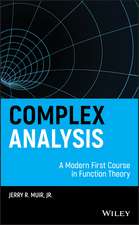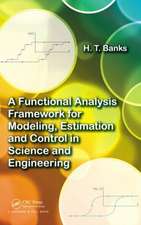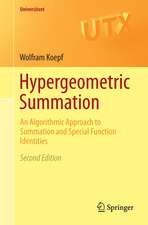The Evolution of Applied Harmonic Analysis: Applied and Numerical Harmonic Analysis
Autor Elena Prestinien Limba Engleză Paperback – 15 dec 2003
"The Evolution of Applied Harmonic Analysis" will engage graduate and advanced undergraduate students, researchers, and practitioners in the physical and life sciences, engineering, and mathematics.
| Toate formatele și edițiile | Preț | Express |
|---|---|---|
| Paperback (2) | 567.32 lei 38-44 zile | |
| Birkhäuser GmbH – 15 dec 2003 | 567.32 lei 38-44 zile | |
| Springer – 29 iun 2018 | 644.63 lei 6-8 săpt. | |
| Hardback (1) | 650.86 lei 6-8 săpt. | |
| Springer – 2 dec 2016 | 650.86 lei 6-8 săpt. |
Din seria Applied and Numerical Harmonic Analysis
-
 Preț: 399.29 lei
Preț: 399.29 lei - 20%
 Preț: 673.02 lei
Preț: 673.02 lei - 17%
 Preț: 431.76 lei
Preț: 431.76 lei - 19%
 Preț: 443.08 lei
Preț: 443.08 lei -
 Preț: 412.57 lei
Preț: 412.57 lei - 15%
 Preț: 550.04 lei
Preț: 550.04 lei - 15%
 Preț: 653.98 lei
Preț: 653.98 lei - 18%
 Preț: 1014.28 lei
Preț: 1014.28 lei - 15%
 Preț: 647.92 lei
Preț: 647.92 lei -
 Preț: 413.37 lei
Preț: 413.37 lei - 15%
 Preț: 648.74 lei
Preț: 648.74 lei - 15%
 Preț: 654.77 lei
Preț: 654.77 lei - 15%
 Preț: 636.80 lei
Preț: 636.80 lei - 15%
 Preț: 532.89 lei
Preț: 532.89 lei - 15%
 Preț: 646.62 lei
Preț: 646.62 lei - 15%
 Preț: 653.98 lei
Preț: 653.98 lei -
 Preț: 397.38 lei
Preț: 397.38 lei - 15%
 Preț: 656.43 lei
Preț: 656.43 lei - 15%
 Preț: 661.97 lei
Preț: 661.97 lei - 18%
 Preț: 957.13 lei
Preț: 957.13 lei - 24%
 Preț: 829.74 lei
Preț: 829.74 lei -
 Preț: 398.35 lei
Preț: 398.35 lei - 20%
 Preț: 569.86 lei
Preț: 569.86 lei -
 Preț: 392.21 lei
Preț: 392.21 lei - 18%
 Preț: 1121.76 lei
Preț: 1121.76 lei - 18%
 Preț: 1001.32 lei
Preț: 1001.32 lei -
 Preț: 387.75 lei
Preț: 387.75 lei - 15%
 Preț: 653.98 lei
Preț: 653.98 lei - 20%
 Preț: 573.77 lei
Preț: 573.77 lei -
 Preț: 406.80 lei
Preț: 406.80 lei -
 Preț: 387.38 lei
Preț: 387.38 lei - 5%
 Preț: 1168.71 lei
Preț: 1168.71 lei -
 Preț: 400.85 lei
Preț: 400.85 lei -
 Preț: 398.15 lei
Preț: 398.15 lei - 15%
 Preț: 644.49 lei
Preț: 644.49 lei - 19%
 Preț: 575.84 lei
Preț: 575.84 lei - 15%
 Preț: 703.71 lei
Preț: 703.71 lei - 20%
 Preț: 334.71 lei
Preț: 334.71 lei - 15%
 Preț: 525.54 lei
Preț: 525.54 lei -
 Preț: 405.06 lei
Preț: 405.06 lei - 15%
 Preț: 536.96 lei
Preț: 536.96 lei
Preț: 567.32 lei
Preț vechi: 709.15 lei
-20% Nou
Puncte Express: 851
Preț estimativ în valută:
108.57€ • 117.89$ • 91.20£
108.57€ • 117.89$ • 91.20£
Carte tipărită la comandă
Livrare economică 18-24 aprilie
Preluare comenzi: 021 569.72.76
Specificații
ISBN-13: 9780817641252
ISBN-10: 0817641254
Pagini: 376
Ilustrații: 1
Dimensiuni: 155 x 235 x 20 mm
Greutate: 0.53 kg
Ediția:2004.
Editura: Birkhäuser GmbH
Seria Applied and Numerical Harmonic Analysis
Locul publicării:Boston, MA, United States
ISBN-10: 0817641254
Pagini: 376
Ilustrații: 1
Dimensiuni: 155 x 235 x 20 mm
Greutate: 0.53 kg
Ediția:2004.
Editura: Birkhäuser GmbH
Seria Applied and Numerical Harmonic Analysis
Locul publicării:Boston, MA, United States
Public țintă
GraduateDescriere
"…can be thoroughly recommended to any reader who is curious about the physical world and the intellectual underpinnings that have lead to our expanding understanding of our physical environment and to our halting steps to control it. Everyone who uses instruments that are based on harmonic analysis will benefit from the clear verbal descriptions that are supplied."
— R.N. Bracewell, Stanford University
A sweeping exploration of essential concepts and applications in modern mathematics and science through the unifying framework of Fourier analysis! This unique, extensively illustrated book describes the evolution of harmonic analysis, integrating theory and applications in a way that requires only some general mathematical sophistication and knowledge of calculus in certain sections.
Key features:
* Historical sections interwoven with key scientific developments showing how, when, where, and why harmonic analysis evolved
* Exposition driven by more than 150 illustrations and numerous examples
* Concrete applications of harmonic analysis to signal processing, computerized music, Fourier optics, radio astronomy, crystallography, CT scanning, nuclear magnetic resonance imaging and spectroscopy
* Includes a great deal of material not found elsewhere in harmonic analysis books
* Accessible to specialists and non-specialists
The Evolution of Applied Harmonic Analysis will engage graduate and advanced undergraduate students, researchers, and practitioners in the physical and life sciences, engineering, and mathematics.
— R.N. Bracewell, Stanford University
A sweeping exploration of essential concepts and applications in modern mathematics and science through the unifying framework of Fourier analysis! This unique, extensively illustrated book describes the evolution of harmonic analysis, integrating theory and applications in a way that requires only some general mathematical sophistication and knowledge of calculus in certain sections.
Key features:
* Historical sections interwoven with key scientific developments showing how, when, where, and why harmonic analysis evolved
* Exposition driven by more than 150 illustrations and numerous examples
* Concrete applications of harmonic analysis to signal processing, computerized music, Fourier optics, radio astronomy, crystallography, CT scanning, nuclear magnetic resonance imaging and spectroscopy
* Includes a great deal of material not found elsewhere in harmonic analysis books
* Accessible to specialists and non-specialists
The Evolution of Applied Harmonic Analysis will engage graduate and advanced undergraduate students, researchers, and practitioners in the physical and life sciences, engineering, and mathematics.
Cuprins
Foreword (R. Bracewell)
Preface
Joseph Fourier: The Man and the Mathematician
Introduction to Harmonic Analysis
Telecommunications and Space Exploration
Fourier Optics and the Synchrotron Light
Sound, Music and Computers
Crystallography: Proteins and DNA Structure
Nuclear Magnetic Resonance: Imaging and Spectroscopy
Computerized Tomography and the Radon Transform
Radioastronomy and Modern Cosmology
Bibliography
Index
Preface
Joseph Fourier: The Man and the Mathematician
Introduction to Harmonic Analysis
Telecommunications and Space Exploration
Fourier Optics and the Synchrotron Light
Sound, Music and Computers
Crystallography: Proteins and DNA Structure
Nuclear Magnetic Resonance: Imaging and Spectroscopy
Computerized Tomography and the Radon Transform
Radioastronomy and Modern Cosmology
Bibliography
Index
Recenzii
"The goal of this text is to introduce readers to the topic of harmonic analysis, its history, and its applications. Throughout the book, these three major concerns...are artfully intertwined to form a single, unified narrative. This is not simply a book about mathematics, or even the history of mathematics; it is a story about how the discipline has been applied (to borrow Fourier's expression) to 'the public good and the explanation of natural phenomena.'
...[T]he author considers a remarkably broad collection of applications, from space exploration to classical music to CAT scans. The treatment of each topic is thorough and comprehensive, paying equal attention to mathematics, application, and historical context.
...It is evident that a great deal of effort has been spent in the preparation of this book. The author has diligently worked to create a cogent, sensibly organized exposition. The text is supplemented with dozens of interesting pictures and graphs....[T]his book constitutes a significant addition to the library of popular mathematical works, and a valuable resource for students of mathematics." —MAA Reviews
"Prestini...traces the development of harmonic analysis from its origins to applications of the present. She begins with a biography of Fourier and a brief description of the mathematics behind Fourier series, then turns to an overview of the many areas of science that have benefited from Fourier's results. The last seven chapters could be seen as a brief history of technology as Prestini takes readers from the early days of telegraphy, radio, and the telephone, through human understanding of sound and optics to more modern technologies such as X-ray crystallography, MRI, and radio astronomy–all filtered through the lens of harmonic analysis. A good read for anyone interested in applied mathematics.... Highly recommended. Upper-division undergraduates through faculty." —CHOICE
"…can be thoroughly recommended to any reader who is curious about the physical world and the intellectual underpinnings that have lead to our expanding understanding of our physical environment and to our halting steps to control it. Everyone who uses instruments that are based on harmonic analysis will benefit from the clear verbal descriptions that are supplied." —From the foreword by R.N. Bracewell, Stanford University
"For a little more than fifty years abstract modern harmonic analysis has evolved in ways independent of physical applications. It has become intertwined with abstract group theory and a host of modern analytical techniques. The broader subject has a much longer history, however, as a branch of applied mathematics, which dates back to the active period of the eighteenth century. The present book is concerned with this longer history as an applied science.
In each of the application areas the author provides a sketch of the underlying mathematical tools borrowed from harmonic analysis. The first area is that of historical origins which dealt with waves and heat diffusion…. The author [also] discusses the topics of the fast Fourier transform, signal sampling, quantization, and filtering that are mainstays of modern digital communications as applied to telecommunications and astrophysics. The topics of sound and light provide graphic demonstrations of the role of the spectrum and higher-dimensional filtering.
Perhaps the most important of all applications are the recent ones to medical technology. One example is provided by computerized axial tomography (CAT scans), which are two-dimensional images (density distributions) resulting from measuring the attenuation of x-rays along different paths and rotational angles perpendicular to the vertical axis of the human body. Building these images as well as combining them to obtain three- dimensional reconstructions requires harmonic analytical transform techniques." —Zentralblatt MATH
"Elena Prestini’s book is not only historically interesting but is also useful. She relates developments in apparently disparate fields. Topics from engineering include telecommunication, wireless telephony, noise, sampling, space propulsion, and space exploration. The fascinating thing about Fourier analysis is that the symbols and terms that become familiar in some particular field translate into analogous but different symbols and terms in many other fields. The mathematical basics remain the same….
As William Thompson (1824–1907, later Lord Kelvin) wrote, ‘Fourier’s theorem is not only one of the most beautiful results of modern analysis, but it may be said to furnish an indispensable instrument in the treatment of nearly every recondite question in modern physics.’ The Prestini book is your guide to a good part of this beauty and universality." —Journal of Astronomical History and Heritage
"The book offers a brief introduction to several fields that are active and central in contemporary science together with the required Fourier analysis and landmarks in their fascinating historic development. Numerous illustrations make the reading easier, while the extensive bibliography may satisfy those in search of deeper knowledge, both scientific and historical." —Mathematical Reviews
"The book under review is a unique and splendid telling of the triumphs of the fast Fourier transform. I can recommend it unconditionally.... Elena Prestini...has taken one major mathematical idea, that of Fourier analysis, and chased down and described a half dozen varied areas in which Fourier analysis and the FFT are now in place. Her book is much to be applauded, for standard textbooks on methods of applied mathematics (as well as teachers) hasten breathlessly from idea to idea, from method to method, from equation to equation, giving short shrift to the wide variety of situations in which any particular idea is actually in use, either commercially or as part of research programs.
After several initial chapters in which she lays out the basics of Fourier analysis very much as might be found in a standard text, Prestini goes on to present what could be described as mini-monographs in six areas: Fourier Optics and Synchrotron Light, X-Ray Crystallography, Radon Transform and Computerized Tomography, Nuclear Magnetic Resonance, Radio Astronomy, and Sound, Music and Computers. In each area, Prestini outlines the history, personalities of the most important contributors, technical background, theory, recent 'down-to-earth' applications, and...analyses via the FFT. She has done her work well, describing with care and in considerable depth what is going on." —SIAM News
...[T]he author considers a remarkably broad collection of applications, from space exploration to classical music to CAT scans. The treatment of each topic is thorough and comprehensive, paying equal attention to mathematics, application, and historical context.
...It is evident that a great deal of effort has been spent in the preparation of this book. The author has diligently worked to create a cogent, sensibly organized exposition. The text is supplemented with dozens of interesting pictures and graphs....[T]his book constitutes a significant addition to the library of popular mathematical works, and a valuable resource for students of mathematics." —MAA Reviews
"Prestini...traces the development of harmonic analysis from its origins to applications of the present. She begins with a biography of Fourier and a brief description of the mathematics behind Fourier series, then turns to an overview of the many areas of science that have benefited from Fourier's results. The last seven chapters could be seen as a brief history of technology as Prestini takes readers from the early days of telegraphy, radio, and the telephone, through human understanding of sound and optics to more modern technologies such as X-ray crystallography, MRI, and radio astronomy–all filtered through the lens of harmonic analysis. A good read for anyone interested in applied mathematics.... Highly recommended. Upper-division undergraduates through faculty." —CHOICE
"…can be thoroughly recommended to any reader who is curious about the physical world and the intellectual underpinnings that have lead to our expanding understanding of our physical environment and to our halting steps to control it. Everyone who uses instruments that are based on harmonic analysis will benefit from the clear verbal descriptions that are supplied." —From the foreword by R.N. Bracewell, Stanford University
"For a little more than fifty years abstract modern harmonic analysis has evolved in ways independent of physical applications. It has become intertwined with abstract group theory and a host of modern analytical techniques. The broader subject has a much longer history, however, as a branch of applied mathematics, which dates back to the active period of the eighteenth century. The present book is concerned with this longer history as an applied science.
In each of the application areas the author provides a sketch of the underlying mathematical tools borrowed from harmonic analysis. The first area is that of historical origins which dealt with waves and heat diffusion…. The author [also] discusses the topics of the fast Fourier transform, signal sampling, quantization, and filtering that are mainstays of modern digital communications as applied to telecommunications and astrophysics. The topics of sound and light provide graphic demonstrations of the role of the spectrum and higher-dimensional filtering.
Perhaps the most important of all applications are the recent ones to medical technology. One example is provided by computerized axial tomography (CAT scans), which are two-dimensional images (density distributions) resulting from measuring the attenuation of x-rays along different paths and rotational angles perpendicular to the vertical axis of the human body. Building these images as well as combining them to obtain three- dimensional reconstructions requires harmonic analytical transform techniques." —Zentralblatt MATH
"Elena Prestini’s book is not only historically interesting but is also useful. She relates developments in apparently disparate fields. Topics from engineering include telecommunication, wireless telephony, noise, sampling, space propulsion, and space exploration. The fascinating thing about Fourier analysis is that the symbols and terms that become familiar in some particular field translate into analogous but different symbols and terms in many other fields. The mathematical basics remain the same….
As William Thompson (1824–1907, later Lord Kelvin) wrote, ‘Fourier’s theorem is not only one of the most beautiful results of modern analysis, but it may be said to furnish an indispensable instrument in the treatment of nearly every recondite question in modern physics.’ The Prestini book is your guide to a good part of this beauty and universality." —Journal of Astronomical History and Heritage
"The book offers a brief introduction to several fields that are active and central in contemporary science together with the required Fourier analysis and landmarks in their fascinating historic development. Numerous illustrations make the reading easier, while the extensive bibliography may satisfy those in search of deeper knowledge, both scientific and historical." —Mathematical Reviews
"The book under review is a unique and splendid telling of the triumphs of the fast Fourier transform. I can recommend it unconditionally.... Elena Prestini...has taken one major mathematical idea, that of Fourier analysis, and chased down and described a half dozen varied areas in which Fourier analysis and the FFT are now in place. Her book is much to be applauded, for standard textbooks on methods of applied mathematics (as well as teachers) hasten breathlessly from idea to idea, from method to method, from equation to equation, giving short shrift to the wide variety of situations in which any particular idea is actually in use, either commercially or as part of research programs.
After several initial chapters in which she lays out the basics of Fourier analysis very much as might be found in a standard text, Prestini goes on to present what could be described as mini-monographs in six areas: Fourier Optics and Synchrotron Light, X-Ray Crystallography, Radon Transform and Computerized Tomography, Nuclear Magnetic Resonance, Radio Astronomy, and Sound, Music and Computers. In each area, Prestini outlines the history, personalities of the most important contributors, technical background, theory, recent 'down-to-earth' applications, and...analyses via the FFT. She has done her work well, describing with care and in considerable depth what is going on." —SIAM News
Textul de pe ultima copertă
"…can be thoroughly recommended to any reader who is curious about the physical world and the intellectual underpinnings that have lead to our expanding understanding of our physical environment and to our halting steps to control it. Everyone who uses instruments that are based on harmonic analysis will benefit from the clear verbal descriptions that are supplied."
— R.N. Bracewell, Stanford University
A sweeping exploration of essential concepts and applications in modern mathematics and science through the unifying framework of Fourier analysis! This unique, extensively illustrated book describes the evolution of harmonic analysis, integrating theory and applications in a way that requires only some general mathematical sophistication and knowledge of calculus in certain sections.
Key features:
* Historical sections interwoven with key scientific developments showing how, when, where, and why harmonic analysis evolved
* Exposition driven by more than 150 illustrations and numerous examples
* Concrete applications of harmonic analysis to signal processing, computerized music, Fourier optics, radio astronomy, crystallography, CT scanning, nuclear magnetic resonance imaging and spectroscopy
* Includes a great deal of material not found elsewhere in harmonic analysis books
* Accessible to specialists and non-specialists
"The Evolution of Applied Harmonic Analysis" will engage graduate and advanced undergraduate students, researchers, and practitioners in the physical and life sciences, engineering, and mathematics.
— R.N. Bracewell, Stanford University
A sweeping exploration of essential concepts and applications in modern mathematics and science through the unifying framework of Fourier analysis! This unique, extensively illustrated book describes the evolution of harmonic analysis, integrating theory and applications in a way that requires only some general mathematical sophistication and knowledge of calculus in certain sections.
Key features:
* Historical sections interwoven with key scientific developments showing how, when, where, and why harmonic analysis evolved
* Exposition driven by more than 150 illustrations and numerous examples
* Concrete applications of harmonic analysis to signal processing, computerized music, Fourier optics, radio astronomy, crystallography, CT scanning, nuclear magnetic resonance imaging and spectroscopy
* Includes a great deal of material not found elsewhere in harmonic analysis books
* Accessible to specialists and non-specialists
"The Evolution of Applied Harmonic Analysis" will engage graduate and advanced undergraduate students, researchers, and practitioners in the physical and life sciences, engineering, and mathematics.
Caracteristici
A sweeping exploration of essential concepts and applications in modern mathematics and science through the unifying framework of Fourier analysis


















